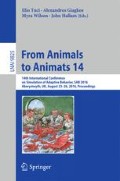Abstract
Robotic systems, whether physical or virtual, must balance multiple objectives to operate effectively. Beyond performance metrics such as speed and turning radius, efficiency of movement, stability, and other objectives contribute to the overall functionality of a system. Optimizing multiple objectives requires algorithms that explore and balance improvements in each. In this paper, we evaluate and compare two multiobjective algorithms, NSGA-II and the recently proposed Lexicase selection, investigating distance traveled, efficiency, and vertical torso movement for evolving gaits in quadrupedal animats. We explore several variations of Lexicase selection, including different parameter configurations and weighting strategies. A control treatment evolving solely on distance traveled is also presented as a baseline. All three algorithms (NSGA-II, Lexicase, and Control) produce effective locomotion in the quadrupedal animat, but differences arise in performance and efficiency of movement. The NSGA-II algorithm significantly outperforms Lexicase selection in all three objectives, while Lexicase selection significantly outperforms the control in two of the three objectives.
Access this chapter
Tax calculation will be finalised at checkout
Purchases are for personal use only
References
Ackerman, J., Seipel, J.: Energy efficiency of legged robot locomotion with elastically suspended loads. IEEE Trans. Robot. 29(2), 321–330 (2013)
Auerbach, J.E., Bongard, J.C.: Environmental Influence on the Evolution of Morphological Complexity in Machines. PLoS Comput. Biol. 10(1), e1003399 (2014)
Beer, R.D.: Toward the evolution of dynamical neural networks for minimally cognitive behavior. In: Proceedings of the Fourth International Conference on Simulation of Adaptive Behavior, vol. 1, pp. 421–429. MIT Press (1996)
Brooks, R.A.: A robot that walks; emergent behaviors from a carefully evolved network. Neural Comput. 1(2), 253–262 (1989)
Cliff, D., Husbands, P., Harvey, I.: Explorations in evolutionary robotics. Adapt. Behav. 2(1), 73–110 (1993)
Clune, J., Beckmann, B.E., Ofria, C., Pennock, R.T.: Evolving coordinated quadruped gaits with the HyperNEAT generative encoding. In: Proceedings of the IEEE Congress on Evolutionary Computation, Trondheim, Norway, pp. 2764–2771 (2009)
Deb, K., Pratap, A., Agarwal, S., Meyarivan, T.: A fast and elitist multiobjective genetic algorithm: NSGA-II. IEEE Trans. Evol. Comput. 6(2), 182–197 (2002)
Doncieux, S., Mouret, J.B.: Behavioral diversity with multiple behavioral distances. In: Proceedings of the 2013 IEEE Congress on Evolutionary Computation, pp. 1427–1434. IEEE, Cancun (2013)
Floreano, D., Husbands, P., Nolfi, S.: Evolutionary robotics. In: Siciliano, B., Khatib, O. (eds.) Handbook of Robotics, pp. 1423–1451. Springer, Berlin (2008)
Gomez, F., Miikkulainen, R.: Active guidance for a finless rocket using neuroevolution. In: Proceedings of the 2003 Genetic and Evolutionary Computation Conference, Chicago, Illinois, USA, pp. 2084–2095 (2003)
Helmuth, T., Spector, L., Matheson, J.: Solving uncompromising problems with Lexicase selection. In: IEEE Transactions on Evolutionary Computation, vol. 99, p. 1 (2014)
Koos, S., Mouret, J.B., Doncieux, S.: Crossing the reality gap in evolutionary robotics by promoting transferable controllers. In: Proceedings of the 2010 ACM Genetic and Evolutionary Computation Conference, pp. 119–126. ACM, Portland (2010)
Lehman, J., Stanley, K.O.: Efficiently evolving programs through the search for novelty. In: Proceedings of the 12th Annual Conference on Genetic and Evolutionary Computation, pp. 837–844. ACM, Portland (2010)
Luke, S., Panait, L.: Lexicographic parsimony pressure. In: Proceedings of the Genetic and Evolutionary Computation Conference, pp. 829–836. Morgan Kaufmann Publishers, New York (2002)
Mouret, J.-B.: Novelty-based multiobjectivization. In: Doncieux, S., Bredèche, N., Mouret, J.-B. (eds.) New Horizons in Evolutionary Robotics. SCI, vol. 341, pp. 139–154. Springer, Heidelberg (2011)
Ollion, C., Doncieux, S.: Towards behavioral consistency in neuroevolution. In: Ziemke, T., Balkenius, C., Hallam, J. (eds.) SAB 2012. LNCS, vol. 7426, pp. 177–186. Springer, Heidelberg (2012)
Paul, C.: Morphological computation: a basis for the analysis of morphology and control requirements. Robot. Auton. Syst. 54(8), 619–630 (2006). http://www.sciencedirect.com/science/article/pii/S0921889006000613
Paul, C., Bongard, J.C.: The road less travelled: morphology in the optimization of biped robot locomotion. In: Proceedings of the 2001 IEEE/RSJ International Conference on Intelligent Robots and Systems, Maui, Hawaii, USA, pp. 226–232 (2001)
Schrum, J., Miikkulainen, R.: Evolving multimodal networks for multitask games. IEEE Trans. Comput. Intell. AI Games 4(2), 94–111 (2012)
Sims, K.: Evolving virtual creatures. In: Proceedings of the 21st Annual Conference on Computer Graphics and Interactive Techniques, pp. 15–22 (1994)
Smith, R.: Open Dynamics Engine (2013). http://www.ode.org/
Spector, L.: Assessment of problem modality by differential performance of Lexicase selection in genetic programming: a preliminary report. In: Proceedings of the 14th Annual Conference Companion on Genetic and Evolutionary Computation, pp. 401–408. ACM, Philadelphia (2012)
Szerlip, P., Stanley, K.O.: Indirectly encoded sodarace for artificial life. In: Proceedings of the 12th European Conference on Artificial Life, Taormina, Italy, pp. 218–225 (2013)
Zitzler, E., Laumanns, M., Thiele, L.: SPEA2: improving the strength Pareto evolutionary algorithm. Technical report, Swiss Federal Institute of Technology (ETH), Zurich (2001)
Acknowledgments
The authors gratefully acknowledge the contributions and feedback provided by Anthony Clark, Xiaobo Tan, Craig McGowan, and members of the BEACON Center at Michigan State University. This work was supported in part by National Science Foundation grants CNS-1059373, CNS-0915855, and DBI-0939454, and by a grant from Michigan State University.
Author information
Authors and Affiliations
Corresponding author
Editor information
Editors and Affiliations
Rights and permissions
Copyright information
© 2016 Springer International Publishing Switzerland
About this paper
Cite this paper
Moore, J.M., McKinley, P.K. (2016). A Comparison of Multiobjective Algorithms in Evolving Quadrupedal Gaits. In: Tuci, E., Giagkos, A., Wilson, M., Hallam, J. (eds) From Animals to Animats 14. SAB 2016. Lecture Notes in Computer Science(), vol 9825. Springer, Cham. https://doi.org/10.1007/978-3-319-43488-9_15
Download citation
DOI: https://doi.org/10.1007/978-3-319-43488-9_15
Published:
Publisher Name: Springer, Cham
Print ISBN: 978-3-319-43487-2
Online ISBN: 978-3-319-43488-9
eBook Packages: Computer ScienceComputer Science (R0)

